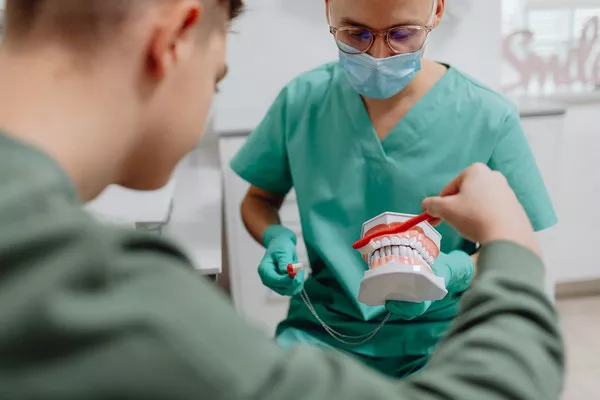Gingivitis is a common form of gum disease characterized by inflammation of the gums caused by plaque buildup. This condition affects many people and, if left untreated, can progress to more severe forms of gum disease. Recognizing the symptoms of gingivitis, understanding its causes, and implementing proper treatment are crucial steps in reversing this condition and maintaining oral health.
Symptoms of Gingivitis
Symptoms of gingivitis include:
Red, swollen gums: Inflammation causes the gums to appear red and puffy.
Bleeding gums: Gums may bleed during brushing or flossing.
Tender gums: Gums may be sensitive to touch or pressure.
Bad breath: Persistent bad breath despite oral hygiene efforts.
Gingivitis is reversible with prompt intervention and proper oral care practices.
Importance of Professional Dental Care
Gingivitis requires professional evaluation by a dentist or dental hygienist to assess its severity and determine an appropriate treatment plan. During a dental examination, your dentist will inspect your gums for signs of inflammation and may measure the depth of spaces between your teeth and gums (pocket depth). This evaluation helps in understanding the extent of gum disease and identifying any contributing factors such as plaque buildup, tartar deposits, or systemic health issues.
Professional dental care is essential as it provides:
Accurate diagnosis: Dentists can identify gingivitis early and prevent it from progressing to more severe forms of gum disease.
Customized treatment: Based on the severity of gingivitis, dentists recommend treatments ranging from professional cleaning to more intensive therapies like scaling and root planing.
While home care plays a significant role, it should complement, not replace, professional dental care for managing gingivitis effectively.
Home Care Tips
Implementing proper oral hygiene practices at home is crucial in managing and reversing gingivitis. Here are key tips to follow:
Proper Brushing Technique
Brush teeth gently: Use a soft-bristled toothbrush and gentle circular motions to clean teeth and gums.
Angle the brush: Hold the brush at a 45-degree angle to the gumline to remove plaque effectively.
Brush for two minutes: Spend adequate time brushing each quadrant of your mouth to ensure thorough cleaning.
Flossing Regularly
Floss once a day: Clean between teeth and along the gumline to remove plaque and food particles.
Use proper technique: Gently curve the floss around each tooth and slide it under the gumline.
Using Antibacterial Mouthwash
Choose an antibacterial mouthwash: Rinse with an antimicrobial mouthwash to reduce bacteria that cause gum disease.
Use after brushing: Incorporate mouthwash into your oral hygiene routine after brushing and flossing.
Dietary Changes
Limit sugary foods: Reduce consumption of sugary drinks and snacks that contribute to plaque buildup.
Eat a balanced diet: Include foods rich in vitamins and minerals that support gum health, such as fruits, vegetables, and lean proteins.
See Also: What Is The Recovery Time For Impacted Wisdom Teeth Removal
Lifestyle Changes
Several lifestyle factors can influence the development and progression of gingivitis:
Quit smoking: Smoking is strongly linked to gum disease and can impair healing. Seek support and resources to quit smoking for better oral and overall health.
Manage stress: Stress can weaken the immune system and exacerbate gum disease. Practice relaxation techniques such as deep breathing, meditation, or yoga.
Professional Treatment Options
When gingivitis progresses beyond mild inflammation, professional treatment may be necessary:
Scaling and Root Planing
Procedure overview: This deep cleaning treatment removes plaque and tartar buildup from teeth and roots.
Benefits: Helps reduce inflammation, prevents progression to periodontitis, and promotes gum healing.
Antibiotics
Prescribed antibiotics: Dentists may prescribe antibiotics to treat bacterial infections associated with gingivitis.
Usage: Antibiotics may be used in conjunction with scaling and root planing or as a standalone treatment for acute gum infections.
Prevention
To prevent gingivitis and maintain optimal oral health:
Maintain good oral hygiene: Brush and floss daily to remove plaque and prevent its buildup.
Regular dental visits: Schedule routine dental checkups and cleanings every six months or as recommended by your dentist.
Adopt a healthy lifestyle: Eat a balanced diet, avoid smoking, and manage stress to support overall gum health.
Conclusion
Gingivitis is a common and reversible form of gum disease that requires proactive management through proper oral hygiene practices and professional dental care. By recognizing the symptoms, seeking timely diagnosis and treatment from a dentist, and implementing effective homecare techniques, individuals can effectively manage and reverse gingivitis. Remember, maintaining good oral health habits and regular dental visits are key to preventing gum disease and ensuring a healthy smile for years to come. If you suspect you have gingivitis or have concerns about your oral health, don’t hesitate to schedule a dental appointment for personalized evaluation and treatment recommendations. Your dentist is your partner in achieving and maintaining optimal oral health.
You Might Be Interested In































